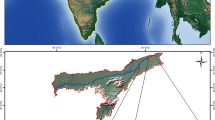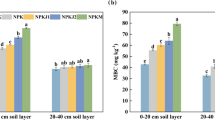Abstract
Aggregate stability is considered to be an appropriate indicator of the relative resistance of soils to detachment by the forces of wind or water. Structural weakness and high rates of erosion in red yellow podzolic (RYP) soils of Matara district are, in general, discussed as prominent problems in intermediate scale agricultural estates. The present study was conducted to ascertain the impacts incurred on the stability of soil aggregates by the alteration of natural forests to agricultural lands, using tea, rubber, and tea/rubber intercropping soils. Surface soils were taken to assess the wet and dry aggregate stabilities, bulk density (DB), clay content, and soil organic carbon (SOC) content. The DB of rubber (1.62 g cm−3) and tea/rubber intercropping (1.61 g cm−3) soils differed significantly (P < 0.05) from forest (1.33 g cm−3) and tea (1.48 g cm−3) soils. Rubber and tea/rubber intercropping soils had significantly high clay contents as well. Forest soil had the highest SOC content, whereas tea, tea/rubber, and rubber soils respectively showed 45, 50, and 70% decline. The aggregate size distribution did not differ noticeably in forest, tea, and tea/rubber intercropping soils. However, rubber soils with the least SOC content had a lower percentage of macro-aggregates (> 0.5 mm) and significantly low wet and dry mean weight diameters. Above results revealed that the changes in land use negatively influenced the SOC pool and the stability of aggregates. Significant and consistent relationship between the carbon stocks and the wet and dry stabilities of aggregates has not been noted. It was clear that the content of SOC would not be considered as the solitary factor that affects wet and dry stabilities of aggregates in the tested Rhodudults.
Similar content being viewed by others
References
Abiven S., Menasseri S. & Chenu C. 2009. The effects of organic inputs over time on soil aggregate stability–A literature analysis. Soil Biol. Biochem. 41: 1–12.
An S., Mentler A., Acosta-Martínez V. & Blum W.E.H. 2009. Soil microbial parameters and stability of soil aggregate fractions under different grassland communities on the Loess Plateau, China. Biologia 64: 424–427.
Cambardella C.A. & Elliott E.T. 1993. Methods for physical separation and characterization of soil organic matter fractions. Geoderma 56: 449–457.
Chenu C., Le Bissonnais Y. & Arrouays D. 2000. Organic matter influence on clay wettability and soil aggregate stability. Soil Sci. Soc. Am. J. 64. 1479–1486.
Devine S., Markewitz D., Hendrix P. & Coleman D. 2014. Soil aggregates and associated organic matter under conventional tillage, no-tillage, and forest succession after three decades. PloS one 9(1). e84988. doi:10.1371/journal.pone.0084988
Jimenez J.J., Lal R., Leblanc H.A. & Russo R.O. 2007. Soil organic carbon pool under native tree plantations in the Caribbean lowlands of Costa Rica. Forest Ecol. Manag. 241: 134–144.
Kemper W.D. & Rosenau R.C. 1986. Aggregate stability and size distribution, pp. 425–442. In: Klute A. (ed.). Methods of Soil Analysis, Part I. (2nd Ed.) Agronomy Monograph 9.
Leelamanie D.A.L. 2014. Initial water repellency affected organic matter depletion rates of manure amended soils in Sri Lanka. J. Hydrol. Hydromech. 62: 309–315.
Leelamanie D.A.L. & Karube J. 2014. Water stable aggregates of Japanese Andisol as affected by hydrophobicity and drying temperature. J. Hydrol. Hydromech. 62: 97–100.
Leelamanie D.A.L., Karube J. & Samarawickrama U.I. 2013. Stability analysis of aggregates in relation to the hydrophobicity of organic manure for Sri Lankan Red Yellow Podzolic soils. Soil Sci. Plant Nutr. 59: 683–691.
Lichner L., Capuliak J., Zhukova N., Holko L., Czachor H. & Kollár J. 2013. Pines influence hydrophysical parameters and water flow in a sandy soil. Biologia 68. 1104–1108.
Lichner L., Hallett P.D., Feeney D.S., Ďugová O., Šír M. & Tesař M. 2007. Field measurement of soil water repellency and its impact on water flow under different vegetation. Biologia 62: 537–541.
Lichner L., Holko L., Zhukova N., Schacht K., Rajkai K., Fodor N. & Sandor R. 2012. Plants and biological soil crust influence the hydrophysical parameters and water flow in an aeolian sandy soil. J. Hydrol. Hydromech. 60: 309–318.
Mapa R.B. & Wanasundara W.M.N.U. 1991. Land use effects on Aggregate size distribution in Reddish Brown Latasolic soils (Rhodudults). J. Soil Sci. Soc. Sri Lanka 7: 91–101.
Mapa R.B. & Gunasena H.P.M. 1995. Effect of alley cropping on soil aggregate stability of a tropical Alfisol. Agroforest. Syst. 32: 237–245.
Munkholm L. J., Schjřnning P., Debosz K., Jensen H. E. & Christensen B. T. 2002. Aggregate strength and mechanical behaviour of a sandy loam soil under long-term fertilization treatments. Eur. J. Soil Sci. 53: 129–137.
National Atlas of Sri Lank. 2007. National Atlas of Sri Lanka. 2nd ed. Survey Departmentof Sri Lanka, Colombo, Sri Lanka.
Panabokke C.R. 1996. Soils and Agro-ecological environments of Sri Lanka: Natural Resources series 2. Natural Resources and Energy Authority of Sri Lanka, pp. 140–163.
Perie C. & Ouimet R. 2008. Organic carbon, organic matter and bulk density relationships in boreal forest soils. Can. J. Soil Sci. 88: 315–325.
Quideau S.A., Chadwick O.A., Benesi A., Graham R.C. & Anderson M.A. 2001. A direct link between forest vegetation type and soil organic matter composition. Geoderma 104: 41–60.
Six J., Feller C., Denef K., Ogle S., Sa J.C.M. & Alain A. 2002. Soil organic matter, biota and aggregation in temperate and tropical soils-Effects of no-tillage. Agronomie 22: 755–775.
Sreekanth N.P., Prabha V.S., Babu P. & Thomas A.P. 2013. Effects of land use conversion on soil carbon storage in a tropical grassland. Ann. Environ. Sci. 7: 101–112.
Author information
Authors and Affiliations
Corresponding author
Rights and permissions
About this article
Cite this article
Leelamanie, D.A.L., Mapa, R.B. Alterations in soil aggregate stability of a tropical Ultisol as mediated by changes in land use. Biologia 70, 1444–1449 (2015). https://doi.org/10.1515/biolog-2015-0168
Received:
Accepted:
Published:
Issue Date:
DOI: https://doi.org/10.1515/biolog-2015-0168




